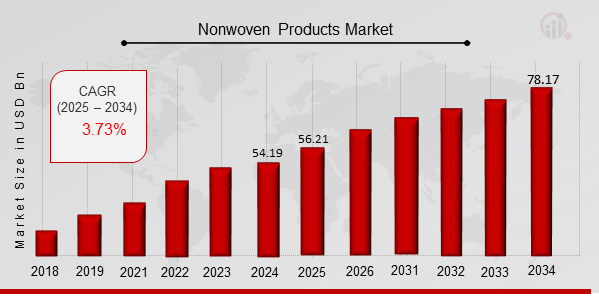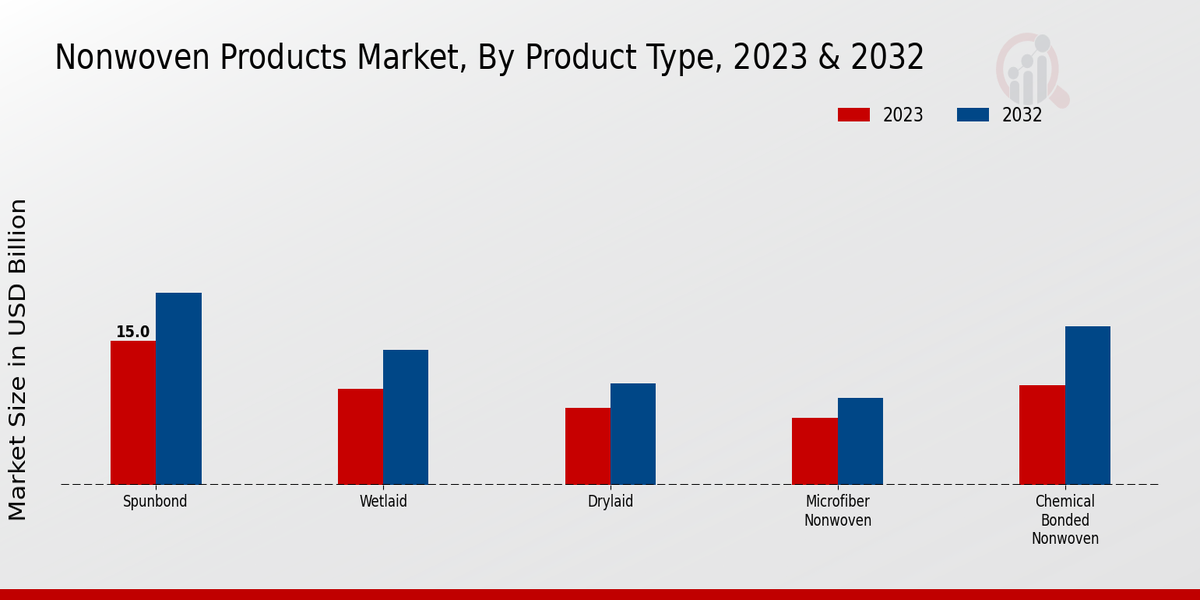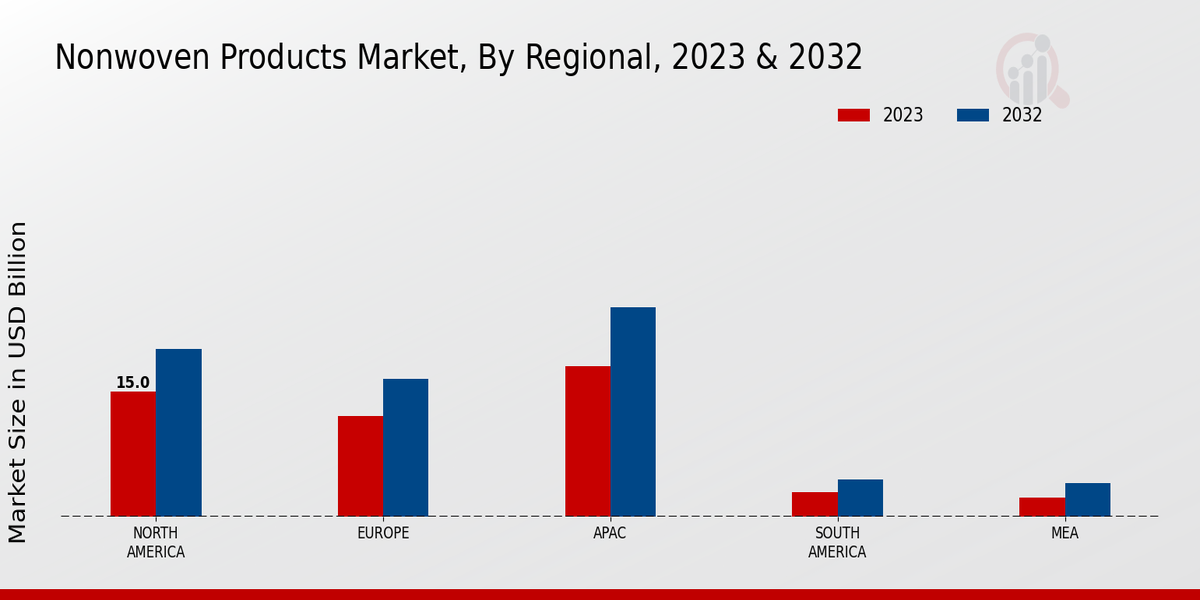Nonwoven Products Market Overview
As per MRFR analysis, the Nonwoven Products Market Size was estimated at 54.19 (USD Billion) in 2024. The Nonwoven Products Market Industry is expected to grow from 56.21 (USD Billion) in 2025 to 78.17 (USD Billion) till 2034, at a CAGR (growth rate) is expected to be around 3.73% during the forecast period (2025 - 2034).
Key Nonwoven Products Market Trends Highlighted
The Nonwoven Products Market is experiencing significant growth driven by several key market drivers. One of the primary factors is the increasing demand for disposable products in sectors like healthcare, hygiene, and personal care.
The healthcare industry, in particular, creates a strong need for nonwoven materials due to their suitability for surgical gowns, masks, and other protective gear.
Additionally, the rising awareness about sustainability and environmental concerns is pushing manufacturers to adopt eco-friendly materials and processes, further driving innovation in nonwoven technologies. There are ample opportunities to be explored in this market.
The growing trend toward sustainability has opened avenues for companies to develop biodegradable, nonwoven products, tapping into the eco-conscious consumer base. With the rise in e-commerce and online shopping, packaging materials that incorporate nonwoven technologies are gaining traction.
Furthermore, the increasing demand for automotive applications presents another opportunity for nonwoven materials, especially those that enhance durability and lightweight characteristics in vehicle manufacturing. Trends in recent times indicate a shift towards multifunctional nonwoven products that cater to various applications.
This shift is fueled by technological advancements, allowing for the production of nonwoven materials with enhanced properties such as moisture-wicking, antibacterial, and lightweight characteristics.
Innovations in manufacturing processes, like the use of advanced bonding techniques, are also contributing to the development of high-performance nonwoven fabrics. The integration of smart textiles into nonwoven products is emerging as another trend, offering capabilities such as moisture control and temperature regulation.
Overall, the Nonwoven Products Market is evolving rapidly, reflecting changing consumer preferences, technological advancements, and broader environmental concerns.

Source: Primary Research, Secondary Research, MRFR Database and Analyst Review
Nonwoven Products Market Drivers
Rising Demand from the Healthcare Sector
The Nonwoven Products Market is experiencing significant growth driven by the increasing demand for nonwoven materials in the healthcare sector. Nonwoven fabrics are widely used in medical and hygiene products due to their exceptional absorbency, softness, and barrier properties.
These materials play a crucial role in manufacturing items such as surgical gowns, masks, and other disposable medical supplies, which have become essential in the wake of global health crises.
As healthcare systems around the world strive to enhance patient safety and combat the spread of infections, the demand for high-quality, nonwoven products continues to rise. Additionally, the ongoing advancements in medical technologies are propelling the development of innovative nonwoven materials that meet the strict standards of the healthcare industry.
Hospitals and healthcare facilities are increasingly adopting nonwoven products not only for their efficiency and effectiveness but also for the cost-saving benefits associated with their use, as they reduce the need for cleaning and sterilization processes.
This trend is expected to persist, contributing significantly to the overall growth and expansion of the Nonwoven Products Market in the coming years.
Sustainability and Eco-Friendliness
An important driver for the Nonwoven Products Market is the growing consumer awareness regarding sustainability and eco-friendliness.
As environmental concerns have risen globally, there is a greater demand for products that are biodegradable and can be produced with minimal impact on the environment. Nonwoven fabric manufacturers are increasingly focused on developing sustainable materials made from recycled fibers, which not only reduce waste but also cater to the eco-conscious consumer.
This alignment with sustainability goals not only enhances brand reputation but also appeals to a wider customer base, thus driving growth in the nonwoven products market.
Technological Advancements in Production Processes
Technological advancements in manufacturing processes are significantly influencing the Nonwoven Products Market. Innovations such as spunbond, meltblown, and airlaid technologies are improving the efficiency and performance of nonwoven fabrics.
These advanced production methods allow for the creation of nonwoven products with enhanced properties, such as increased strength, durability, and functionality. As these technologies continue to evolve, manufacturers can meet the specific needs of different industries, such as automotive, construction, and personal care, thus broadening the applications and driving market growth.
Nonwoven Products Market Segment Insights
Nonwoven Products Market Product Type Insights
The Nonwoven Products Market has been divided into various product types that cater to a range of applications and industries.
Among these, the Spunbond segment had established itself as a significant player, with a market valuation of 15.0 USD billion in 2023 and projected to reach 20.0 USD billion by 2032. This product type is known for its versatility and is a major contributor to agricultural and medical applications due to its durability and lightweight, thus holding a majority share in the overall market.
Following closely was the Wetlaid segment, which is valued at 10.0 USD billion in 2023, expected to grow to 14.0 USD billion by 2032. This segment is predominant in hygiene products and provides excellent liquid absorption, making it vital for the production of absorbent materials.
The Drylaid segment, valued at 8.0 USD billion in 2023 and projected at 10.5 USD billion in 2032, is notable for its use in applications demanding high strength and flexibility, particularly in the automotive and construction industries.
In terms of Specialized applications, the Microfiber Nonwoven segment contributed substantially to the market, valued at 7.0 USD billion in 2023 and anticipated to grow to 9.0 USD billion by 2032, being essential for cleaning and filtration applications due to its ultra-fine fibers.
Lastly, the Chemical Bonded Nonwoven segment, with a valuation of 10.36 USD billion in 2023, growing to 16.5 USD billion by 2032, played a crucial role in automotive and agricultural applications thanks to its strength and durability, further enhancing the diversity of the Nonwoven Products Market.
Collectively, these product types illustrate the robust segmentation within the market, each contributing uniquely to the overall growth story marked by expanding applications and increasing demand across multiple industries.
The market is characterized by trends driven by technological advances and sustainability, presenting both challenges and opportunities for further expansion in the Nonwoven Products Market.

Source: Primary Research, Secondary Research, MRFR Database and Analyst Review
Nonwoven Products Market Material Insights
The demand for various materials, such as Polypropylene and Polyester, has been significant, driven by their excellent characteristics, including durability and versatility, making them ideal for applications in hygiene, medical, and construction sectors. Polypropylene continues to dominate due to its favorable properties and cost-effectiveness, ensuring its widespread adoption across various industries.
Additionally, Viscose and Polyethylene are also gaining traction as sustainable alternatives, meeting the rising consumer demand for environmentally friendly products. The Nonwoven Products Market data underscores how these materials are pivotal in addressing the changing dynamics of end-user requirements and regulatory standards.
As market trends evolve, the emphasis on high-performance fibers presents opportunities for innovations and diversification within the industry, further enhancing the Nonwoven Products Market statistics through the introduction of advanced features in nonwoven products.
Keeping abreast of these developments is essential for stakeholders as they navigate the challenges and opportunities within this expanding market sector.
Nonwoven Products Market Application Insights
The medical field has seen increased utilization of nonwoven materials for their critical role in producing surgical gowns, masks, and other healthcare supplies, reflecting the rising focus on hygiene and safety.
In hygiene products, demand remains strong, driven by the growing preference for disposable items like diapers and feminine hygiene products, which greatly benefit from the absorbent and soft characteristics of nonwovens.
The automotive sector also plays a vital role, utilizing nonwoven fabrics for sound absorption and insulation, thus enhancing both comfort and energy efficiency. Meanwhile, construction applications leverage nonwovens for roofing, insulation, and geotextiles, which assist in soil erosion control and drainage.
Collectively, these segments demonstrate the versatility of nonwoven products and their essential role across various industries, aligning well with the trends of sustainability and cost-effectiveness within the Nonwoven Products Market.
Nonwoven Products Market End Use Insights
Within the market, the End Use segmentation showcases diverse applications, including Consumer Goods, Industrial, Medical, and Agriculture. The Consumer Goods segment plays a pivotal role, driven by rising demand for hygiene products and personal care items. In addition, the medical sector is significant, attributed to the increasing requirement for hygienic and breathable materials in healthcare settings.
The Industrial segment demonstrates its importance through the usage of nonwovens in filtration and geotextiles, while Agriculture benefits from nonwoven fabrics used in crop protection and soil stabilization.
Overall, these segments highlight critical growth drivers fueled by innovations and sustainable practices in the Nonwoven Products Market, contributing to the market growth and enhancing its value proposition.
As trends evolve, opportunities abound in each area, aligning with changing consumer needs and environmental awareness, reinforcing the relevance of Nonwoven Products Market revenue and statistics.
Nonwoven Products Market Regional Insights
The Nonwoven Products Market showcases a diverse regional segmentation, each contributing uniquely to its overall value. In 2023, North America held a significant position with a market valuation of 15.0 USD billion, expected to rise to 20.0 USD billion by 2032, indicating its majority holding in the market, driven by high demand for industrial applications.
Europe followed closely with a valuation of 12.0 USD billion in 2023, scaling to 16.5 USD billion in 2032, reflecting the region's focus on sustainability and advanced technologies.
The APAC region led the segmentation with a valuation of 18.0 USD billion in 2023, projected to reach 25.0 USD billion in 2032, highlighting its rapid industrialization and increasing consumer demand for nonwoven fabrics in hygiene products.
South America, although smaller, with a valuation of 3.0 USD billion in 2023, is expected to grow steadily to 4.5 USD billion, indicating emerging opportunities in the healthcare and environmental sectors.
Lastly, the MEA region, valued at 2.36 USD billion in 2023 and projected to reach 4.0 USD billion by 2032, represented a growing market influenced by urbanization and improving economic conditions, although it remains the least dominant in this segmentation.
The overall dynamics within these regions reflect varying drivers such as technological advancements, increased consumption in the healthcare and hygiene industries, and a strong emphasis on eco-friendly products, presenting both challenges and opportunities in the Nonwoven Products Market.

Source: Primary Research, Secondary Research, MRFR Database and Analyst Review
Nonwoven Products Market Key Players and Competitive Insights:
The Nonwoven Products Market has seen significant growth and transformation in recent years, driven by various factors such as increasing demand for sustainable materials, changes in consumer preferences, and advancements in manufacturing technologies.
The competitive landscape is marked by a multitude of players ranging from established multinational corporations to emerging market participants, each vying for market share through innovation and strategic positioning.
The utilization of nonwoven materials spans numerous applications, including hygiene products, medical supplies, and automotive textiles, leading to intense competition among manufacturers.
Market participants are constantly working on developing new products and improving their production processes to enhance efficiency and reduce environmental impacts, creating a dynamic arena where companies must stay ahead of trends and consumer needs to maintain a competitive edge.
Within the Nonwoven Products Market, DuPont stands out as a key player, leveraging its deep expertise in materials science to deliver high-performance nonwoven solutions. The company boasts a robust portfolio of products that cater to various sectors, including personal care, medical, and industrial markets.
One of DuPont's key strengths lies in its strong brand recognition, coupled with significant investment in research and development, allowing it to consistently innovate and launch new offerings that meet stringent quality and regulatory standards.
Additionally, DuPont has established a global presence with well-distributed manufacturing facilities, ensuring that it can meet diverse customer needs across different regions efficiently. Their commitment to sustainability also enhances their market position by aligning with the growing consumer demand for eco-friendly products.
On the other hand, Nonwoven is another prominent entity in the Nonwoven Products Market, known for its innovative approaches and specialized offerings. The company focuses on delivering customized nonwoven solutions tailored to meet specific application requirements, making it a preferred partner for many industries.
sandC Nonwoven's key strengths include a strong emphasis on quality control and operational excellence, which allows the firm to provide reliable and high-performing products. The company invests significantly in advanced technologies and equipment for production, thereby improving efficiency and product consistency.
Furthermore, sandC Nonwoven's strategic partnerships and collaborations within the industry enable it to access new markets and enhance its product line, solidifying its competitive position in the nonwoven landscape.
Key Companies in the nonwoven products market Include
- DuPont
- sandC Nonwoven
- TWE Group
- Sealion Nonwovens
- Berry Global
- Kimberly-Clark
- Mogul Nonwovens
- Freudenberg
- Sunkiss Nonwovens
- First Quality
- Fitesa
- Glatfelter
- Japan Vilene Company
- XFIL
Nonwoven Products Market Developments
In recent developments within the Nonwoven Products Market, DuPont announced advancements in sustainable nonwoven materials, highlighting increased market interest in eco-friendly solutions. Meanwhile, TWE Group has focused on expanding its product lines to meet growing demand in the hygiene sector, emphasizing innovations that enhance customer satisfaction.
Berry Global and Kimberly-Clark are collaborating on developing advanced nonwoven textile solutions, which has led to increased market visibility and competitiveness. Additionally, Mogul Nonwovens has reported a significant uptick in production capacity, addressing rising demand from the medical and hygiene sectors.
Acquisitions also mark the landscape, with Freudenberg acquiring a smaller nonwoven manufacturing firm to broaden its product offerings, enabling it to better serve the global market. Japan Vilene Company has expanded its presence in North America, indicating geographic growth strategies among key players.
Overall, these developments reflect a dynamic market environment increasingly influenced by sustainability, innovation, and strategic partnerships among leading companies like Sunkiss Nonwovens, First Quality, Fitesa, Glatfelter, and XFIL.
Nonwoven Products Market Segmentation Insights
Nonwoven Products Market Product Type Outlook
- Spunbond
- Wetland
- Drylaid
- Microfiber Nonwoven
- Chemical Bonded Nonwoven
Nonwoven Products Market Material Outlook
Nonwoven Products Market Application Outlook
- Medical
- Hygiene Products
- Automotive
- Construction
- Geotextiles
Nonwoven Products Market End Use Outlook
- Consumer Goods
- Industrial
- Medical
- Agriculture
Nonwoven Products Market Regional Outlook
-
North America
-
Europe
-
South America
-
Asia Pacific
-
Middle East and Africa
| Report Attribute/Metric |
Details |
|
Market Size 2024
|
54.19 (USD Billion)
|
|
Market Size 2025
|
56.21 (USD Billion)
|
|
Market Size 2034
|
78.17 (USD Billion)
|
|
Compound Annual Growth Rate (CAGR)
|
3.73 % (2025 - 2034)
|
|
Report Coverage
|
Revenue Forecast, Competitive Landscape, Growth Factors, and Trends
|
|
Base Year
|
2024
|
|
Market Forecast Period
|
2025 - 2034
|
|
Historical Data
|
2020 - 2024
|
| Market Forecast Units |
USD billion |
| Key Companies Profiled |
DuPont, sandC Nonwoven, TWE Group, Sealion Nonwovens, Berry Global, Kimberly-Clark, Mogul Nonwovens, Freudenberg, Sunkiss Nonwovens, First Quality, Fitesa, Glatfelter, Japan Vilene Company, XFIL |
| Segments Covered |
Product Type, Material, Application, End Use, Regional |
| Key Market Opportunities |
Sustainable material demand growth, Expansion in hygiene products, Innovative applications in healthcare, Rising automotive sector utilization, Strong growth in filtration systems |
| Key Market Dynamics |
rising demand for hygiene products, increased applications in healthcare, sustainable material innovations, growing adoption in the automotive industry, expanding packaging solutions market |
| Countries Covered |
North America, Europe, APAC, South America, MEA |
Frequently Asked Questions (FAQ) :
The Nonwoven Products Market is expected to be valued at 78.17 USD billion in 2034.
The Nonwoven Products Market is projected to have a CAGR of 3.73% from 2024 to 2034.
The APAC region is expected to lead the market, reaching a value of 25.0 USD billion in 2032.
The market size for Spunbond is projected to reach 20.0 USD billion by 2032.
Key players in the market include DuPont, Berry Global, and Kimberly-Clark, among others.
The Wetlaid segment is expected to reach a market size of 14.0 USD billion by 2032.
The North American market is expected to be valued at 20.0 USD billion in 2032.
The Chemical Bonded Nonwoven segment is expected to grow to 16.5 USD billion by 2032.
Emerging trends include increased demand for sustainable materials and innovative production technologies.
The Drylaid segment is anticipated to reach a market size of 10.5 USD billion by 2032.

















